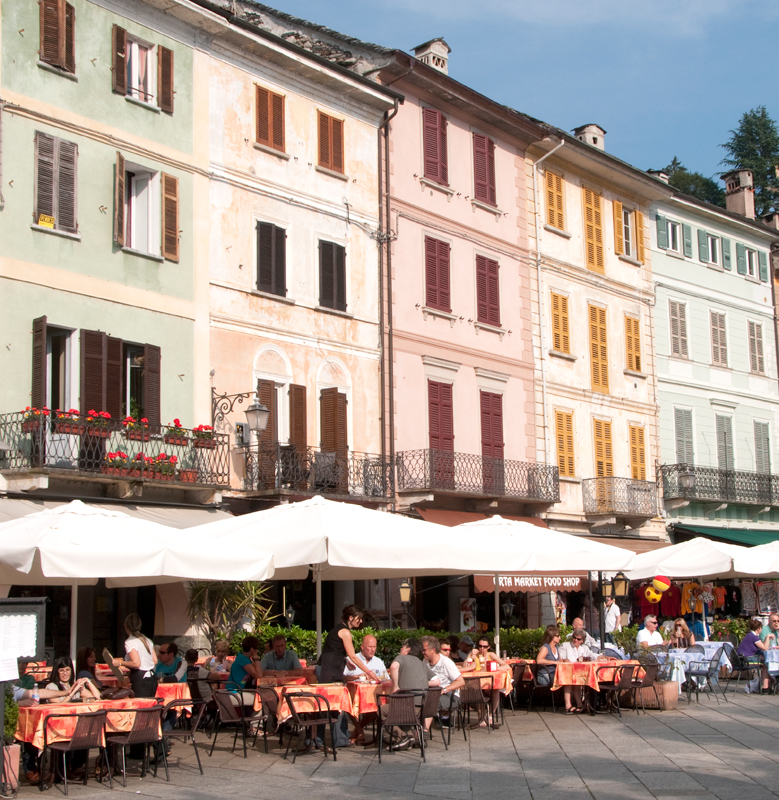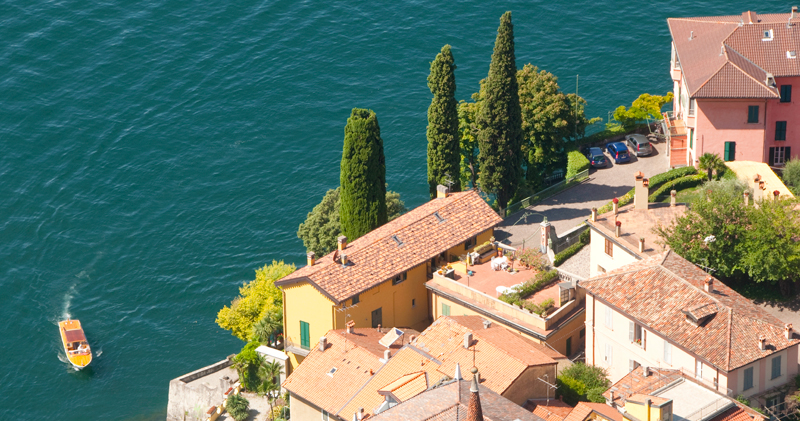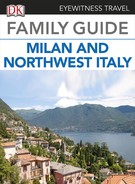< Introducing Milan and Northwest Italy
The Best of Milan and Northwest Italy

Cafés lining Piazza Motta in Orta San Giulio, the main resort on the shores of Lake Orta
This part of Italy offers mountains, sea, lakes and several appealing cities, with an enticing array of activities. Simply travelling around here is an adventure, whether traversing lakes by ferry or getting lost in a maze of narrow alleyways in Genoa’s old town. There is exceptional architecture and art in the cities of Bergamo, Mantua, Turin and Milan, while beaches and coves can be found on the Ligurian Riviera.
On the water
Lake Orta is small, mystical and romantic, with Orta San Giulio probably the prettiest medieval village in all the lakes. Boats cross to the island, Isola di San Giulio, five minutes’ journey across the water. The waters off the Ligurian coast are home to dolphins and, perhaps surprisingly, 12 species of whale swim the open sea. The thousand-year-old Abbey of San Fruttuoso is accessible only by boat or on foot: take a ferry from virtually any harbour on the Portofino headland, and enjoy a simple lunch at a trattoria on the small pebble beach. To enjoy the charms of
Lake Como, catch a ferry – the sweeping shoreline and magnificent villas look their best from the water, and the lake is never more than 5 km (3 miles) wide, so it is easy to harbour-hop. At Mantua, small pleasure boats sail on the River Mincio; take bikes – it is possible to cruise in the morning, picnic at lunchtime and have a leisurely pedal back in the afternoon.

A view down onto the rooftops of Varenna from the Castello di Vezio above Lake Como
In a week
Begin with a night or two in a city of a manageable size, such as Turin, Mantua or Bergamo, to get into the swing of sightseeing, gelato-eating and the daily passeggiata (evening stroll), then home in on two or three key sights on a flying visit to Milan. Next, choose between the mountains – perhaps a trip up Monte Bianco, the Italian side of Mont Blanc – or the lakes. Alternatively, head for the Ligurian coast, staying in a fishing port such as Camogli, which English writer Charles Dickens called “the saltiest, most piratical little place”. Combine beach trips with day trips to Genoa to visit the attractions of the renovated Porto Antico.
By season
In spring, enjoy the lakes,
Lake Como and Lake Orta, where after Easter it is warm enough to eat outdoors, but the crowds have yet to arrive. On the Ligurian Riviera, the Sagra del Pesce, a huge fish fry-up in aid of the patron saint of fishermen, takes place in Camogli on the second Sunday in May. In late May the Idroscalo in Festa brings picnics, concerts and sporting events to Milan.
Summer is the best time to hike in the Parco Nazionale del Gran Paradiso in the Valle d’Aosta. The Ligurian Riviera bursts into life at this time of year and, although busy, this is the most fun time to visit. There are concerts in the Abbey of San Fruttuoso and, on the last Saturday in July, a torch-lit boat procession to the Cristo degli Abissi, eight fathoms below on the seabed. It is hot in the big cities, which are best avoided.
Autumn is a glorious time to visit Mantua and sample the tortelli di zucca (pumpkin-stuffed pasta). Violin-makers’ town Cremona is well visited now too. If dry, autumn is ideal for walks in the Cinque Terre. It is also a good time to visit Milan as the summer heat dies down and families return from the seaside.
In winter, more than 30 artists claim a street or piazza in Turin as their own for the Christmas Luci d’Artista Torino (Festival of Lights). Epiphany in Milan is known as La Befana, after the kind witch who brings presents to good children; on 6 January a costumed procession of the Three Kings travels from the Duomo to the Church of Sant’Eustorgio, said to be the final resting place of the Magi. Piazza Duomo is the hub of Milan’s Carnevale (Feb–Mar), one of the best times for children in the city. In the mountains, Courmayeur offers winter sports and the Parco Avventura Mont Blanc has a wide range of winter sporting activities on offer, suitable for children and adults of all abilities.

The magnificent façade of Milan’s Duomo
Eat your way around…
Some well known Italian foods come from northwest Italy. Try fresh pesto, basil pounded with pine nuts, olive oil and Parmesan, in Liguria. The stubby-grained arborio or carnaroli rice grown in the flood plains of the Po, west of Milan, is used to make risotto. If Italians want to insult people from Lombardy, they call them polentoni or “polenta eaters”; cornmeal polenta was once the food of the poor, but these days classy restaurants feature it and the Bergamese have formed the Ordine dei Cavalieri della Polenta (Order of the Knights of Polenta). Taleggio, a tangy, soft cows’ milk cheese, is served at the end of a meal in Bergamo, with tasty farmhouse versions to be found in the countryside of the Lombardy plain. Focaccia, a dimpled flatbread with rosemary and sea salt, comes from Liguria where it is sold as fast food. Creamy tiramisù owes its richness to the soft mascarpone cheese from Lodi, southwest of Milan, while Turin is credited with inventing zabaglione, a rich egg-yolk, sugar and dessert wine confection.
..................Content has been hidden....................
You can't read the all page of ebook, please click here login for view all page.
